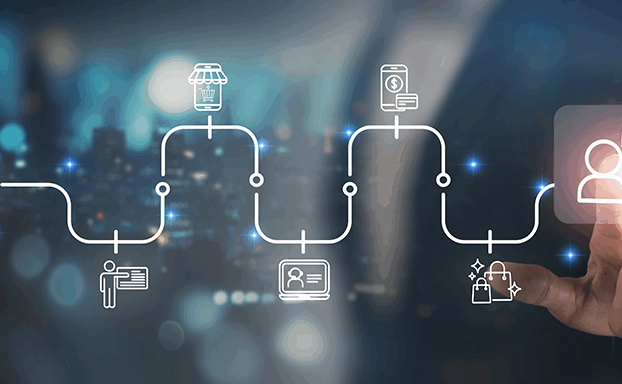The data center landscape is rapidly changing. As data centers embrace new connection strategies and expand into hybrid environments, increasingly complex networks are created that preclude end-to-end visibility into their health and performance.1 Yet, these changes are necessary for accommodating unprecedented application flexibility while adapting to murkier workflows and even bigger data.2 So, how can businesses evolve their data center operations to accommodate new technology and increased performance demands?
For many businesses, the answer is data center analytics. By gathering and analyzing data, businesses can gain valuable insight into their data center operations. This insight can directly influence the development of more efficient processes, turning a data center into a data-driven operation.
But how does a business know when to start leveraging data analytics, and what are the actual benefits of adopting a data-driven strategy? We asked one of our Data Center experts to share his perspective.
Meet Lou Noble
Lou Noble began his career in tech in 1995 and is currently a Senior Director for Milestone’s Operations team, supporting IT Relocations, Cloud and Data Center Implementations, Build Services, Asset Lifecycle Management (ALM), and Sites Services.
What are data center analytics?
To better understand the value of analytics, it is important to clarify the difference between data center operations and data center analytics. Whether it is rerouting data flow on servers or fixing hardware issues, data center operations are the day-to-day tasks necessary for maintaining a business’ data center. Data center analytics, however, are the platforms, people, and processes layered on top of operations. Performing analytics involves meticulous data-gathering platforms that produce metrics for data center technicians to assess, model, and analyze.
From that analysis, data center technicians are able to gain insight into the root cause of the problems the data center is encountering. This insight then drives process refinement and substantiates the methodology governing day-to-day operations. If a server goes down, data center operations fixes the issue, but analytics allow technicians to understand the reason the issue occurred in the first place. In this regard, analytics are the strategic insights that inform the tactical maneuvers performed by data center operations.
How have analytics changed the way traditional data centers work?
Although raw data provides a degree of visibility into the performance of a data center, the process of analyzing that data enables businesses to understand the drivers behind that performance. In essence, analytics have provided businesses with key insight into the reason(s) why their data center performs the way it does. With that insight, businesses are able to make better hardware and process improvements that directly affect their users and customers.
In the past, when a component within a business’ data center failed, a technician would replace the part and move on. By leveraging analytics, however, that business can identify underperforming equipment that is burdening them with significant maintenance costs and optimize operational methodologies that bolster performance, all of which directly contributes to improving the customer experience.
Analytics also reveal whether large overhaul projects should take place and empower businesses to make more informed decisions with the hardware it uses and the vendors it partners with.
What are some of the challenges that indicate the need for analytics in a data center?
Any of the following issues are indicators that a data center should be leveraging analytics:
Performance: If businesses notice lagging devices, packet loss, or networks that are struggling with bandwidth demands, then clearly there is a component in the data center that is not performing properly. Without analytics, businesses cannot easily identify choke points in their data flows or inefficiencies in device management or operations.
Cost: Increasing maintenance costs are another good indicator of the need for analytics. Without insight into the load-bearing capabilities of certain key pieces of hardware, data center components that continuously fail under pressure cannot be easily identified—and then businesses cannot make informed decisions about the equipment and vendors they utilize.
Compliance: Lastly, if businesses are unable to maintain consistent version control in their software or are failing to meet security compliance standards, the root cause is likely a lack of understanding.
Having said that, the customer experience is also a major indicator. All the aforementioned indicators contribute to prolonged downtime, which prevents businesses from delivering their products and services to their customers. Downtime costs businesses significant revenue, and — more importantly — drastically impacts customer satisfaction.
What are the incentives for becoming data-driven?
Cost savings and the customer experience are without a doubt major incentives for leveraging analytics to create a data-driven operation. However, consistency is also incredibly important and often overlooked. As more organizations leverage colocations or move their data centers into hybrid or cloud-based environments, maintaining consistency across the entire data center topology becomes more difficult. Analytics afford businesses the ability to apply standards across disparate parts, ensuring that no individual component is siloed out. This contributes to the health and performance of a data center by keeping it intact, which provides a baseline for all other data center optimization initiatives.
What kind of data should businesses collect and analyze from their data centers?
Performance data: Without analytics, businesses lack important insight into the lifecycle of their assets. Tracking how data centers handle bandwidth demands or how well the load optimizers are mitigating information traffic choke points is always beneficial for optimizing performance. Packet loss percentages or thermal issues with equipment are all diagnostics that businesses should be analyzing regularly. This kind of data influences high-level business decisions like manufacturer purchases and vendor partnerships.
Security data: Without insight into the state of network security, businesses have no way of ensuring consistency with access policies and security software like virus protection. While this lack of insight erodes a business’ ability to remain compliant with security standards, it also creates vulnerabilities that can be exploited to steal customer information and compromise a business’ integrity. Consequently, leveraging analytics to continually assess data center security will go a long way toward avoiding costly information breaches that tarnish a business’ reputation.
How can analytics and automation work together?
Automation and analytics can be used in conjunction to create a centralized, living data center environment. Suppose a business is tracking the rate at which certain network switches drop packets. That business can then build an automated process to notify on-site technicians so that they can use analytics to understand the root cause of the problem. If the data indicates that this kind of switch chronically suffers this same issue, then it may be time for that business to consider a different piece of equipment. Analytics working together with automation produces a self-regulating organism.
However, that doesn’t make the human element irrelevant. In fact, when analytics and automation work hand in hand, data center technicians are free to spend more time focusing on strategic process improvement instead of rectifying each incident as it appears.
Data Center Analytics Checklist
Considering the challenges many businesses face with managing their data centers, data analytics offer significant incentives for companies willing to implement it effectively. To recap, analytics enable businesses to:
Assess
- Analyze pain points
- Create a performance baseline
- Map workload patterns
- Perform Root-Cause Analysis (RCA)
- Reveal security anomalies
- Discover correlations between platforms
Optimize
- Predict choke points
- Take preventative action
- Fine-tune network performance
- Remediate exploitable vulnerabilities
- Make informed business decisions and ensure scalability
As technology and performance requirements evolve, data center analytics keep businesses on the cutting edge of IT by enabling insight, optimizing operations, ensuring scalability, and improving the customer experience. To learn more about how data center analytics can augment data center operations, consult our Data Center Operations Best Practices Guide.
1 http://www.ingrammicroadvisor.com/data-center/key-benefits-of-managing-data-center-operations-with-analytics
2 http://www.informationweek.com/big-data/big-data-analytics/analytics-can-solve-big-data-center-challenges/a/d-id/1328411






